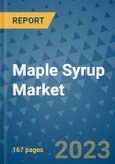The global maple syrup market is set for robust growth, with sales expected to soar from approximately US$1.7 billion in 2022 to an estimated US$2.4 billion by 2030. This promising outlook is driven by several key factors, including increasing consumer demand for natural and organic sweeteners, the rising prevalence of health-related concerns such as heart disease, diabetes, and obesity, and the popularity of maple syrup as a sugar substitute. These insights are part of a comprehensive market analysis, which also forecasts an impressive CAGR of 6% between 2023 and 2030 for the global maple syrup market.Global maple syrup sales worth around US$1.7 Bn (2022) likely to soar till US$2.4 Bn by 2030
Rising Consumer Demand for Healthier Alternatives
Consumer preference for natural and organic sweeteners has played a significant role in boosting the acceptance and consumption of maple syrup. Recognized as a healthier and more nutrient-dense alternative to refined sugar and artificial sweeteners, maple syrup stands out due to its high mineral and phenolic content. It contains organic acids, amino acids, and essential minerals such as zinc, potassium, and manganese, making it a superior choice for health-conscious consumers. The global trend toward healthier dietary choices, driven by an aging population and increased health awareness, is expected to fuel the demand for calorie-free, natural sweeteners like maple syrup.
Rapid Expansion of Bakery and Confectionery Sector
The growth of the bakery and confectionery industry, coupled with changing consumer lifestyles, has led to a surge in maple syrup usage. As urbanization and the trend toward independent living continue, consumer spending on upscale dining experiences, including coffee shops offering baked goods like pancakes, bread, and cookies, has increased. Maple syrup, with its lower sugar content compared to honey and sugar syrup, is becoming a favored flavoring for these baked products. The consistent rise in bakery consumption is expected to further drive the demand for maple syrup as a key ingredient.
Favorable Bilateral Trade Agreements
Maple syrup is predominantly produced in North American countries, particularly Canada and the United States, due to favorable climatic conditions for maple tree growth. Other countries rely on these North American suppliers to meet their domestic demand. The increase in trade activities and bilateral agreements between North American maple producers and other nations has facilitated the expansion of maple syrup markets worldwide. Supportive legislation, such as the reduction or elimination of import/export taxes, has further boosted market growth, making maple syrup more accessible to consumers globally.
Challenges and Opportunities
While the global maple syrup market presents significant opportunities, it also faces challenges. Strict government regulations in Canada and the United States ensure high product quality but can increase manufacturing costs and impact profit margins. Additionally, growing health concerns related to conditions like diabetes and obesity have prompted consumers to seek healthier sugar alternatives, benefiting maple syrup.
Key Trends and Opportunities
Rising Labelling Trends: Consumers place importance on the country of origin when making purchasing decisions. Labels indicating the source of maple syrup can influence consumer perceptions of quality, safety, and freshness.
Adoption of New Dietary Regimes: The popularity of veganism and environmentally friendly diets has created opportunities for maple syrup as a vegan-friendly sugar substitute rich in essential nutrients.
Increasing Adoption as a Sugar Alternative: With lifestyle diseases on the rise, consumers are turning to active lifestyles and diet programs recommending sugar substitutes like maple syrup to combat obesity and diabetes.
Regional Frontiers
North America: The region, driven by increasing interest in maple products and healthy foods, is experiencing market expansion. Maple syrup is used as a sugar substitute in various meals, including sweets and baked goods.
Europe: Europe is the second-largest market contributor, with France, Germany, and the UK being major importers of maple syrup from Canada. High demand and purchasing power of consumers are driving regional growth, although Europe relies on imports from North America.
Competitive Landscape
The global maple syrup market features fewer large competitors and has witnessed consolidation. Leading companies are expanding their product lines, enhancing distribution networks, and investing in marketing campaigns and social media promotion to further strengthen their global presence.
Leaders in Global Maple Syrup Space:
- Maple Joe
- The Kraft Heinz Company
- Les Industries Bernard et Fils Ltee
- Canadian Maple Company
- Ontario Maple Syrup Producers Association
- Bascom Maple Farms, Inc
- Thompson's Maple Products
- B&G Foods
- Canadian Organic Maple Co. Ltd
- Citadelle Camp.
- Vermont
- Stonewall Kitchen
- Valeo Foods
- M Smucker
- LB Maple Treat.
This product will be delivered within 1-3 business days.
Table of Contents
1. Executive Summary
2. Market Overview
3. Global Maple Syrup Market Outlook, 2018 - 2030
4. North America Maple Syrup Market Outlook, 2018 - 2030
5. Europe Maple Syrup Market Outlook, 2018 - 2030
6. Asia Pacific Maple Syrup Market Outlook, 2018 - 2030
7. Latin America Maple Syrup Market Outlook, 2018 - 2030
8. Middle East & Africa Maple Syrup Market Outlook, 2018 - 2030
9. Competitive Landscape
10. Appendix
Companies Mentioned
- Maple Joe
- The Kraft Heinz Company
- Les Industries Bernard et Fils Ltee
- Canadian Maple Company
- Ontario Maple Syrup Producers Association
- Bascom Maple Farms, Inc
- Thompson's Maple Products
- B&G Foods
- Canadian Organic Maple Co. Ltd
- Citadelle Camp.
- Vermont
- Stonewall Kitchen
- Valeo Foods
- J.M Smucker
- LB Maple Treat
Methodology

LOADING...








